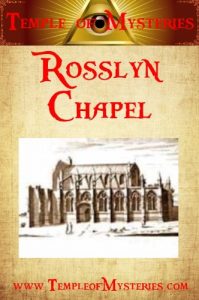The Mystery
What is it that brings so many people to this out-of-the-way chapel? Not only is Rosslyn Chapel (or, to give it its official title, the Collegiate Church of St Matthew) a stunning example of late medieval architecture and the stonemason’s art, but it contains many clues that it is more than just a place of worship – and even that it was never intended to be simple a Christian church.
History of Rosslyn Chapel
The mastermind behind the project was Sir William St Clair, known as 'Prodigus', 3rd Prince of Orkney. Sir William was the grandson of Prince Henry St. Clair of Orkney, known as 'the Navigator', who many believe led an expedition to America a hundred years before Columbus's 'discovery' of the New World.
The Mystery of the Carvings
Although ostensibly, like other collegiate churches, Rosslyn Chapel was intended as a place of Christian learning, there is much to suggest that Sir William St Clair's intentions were, to say the least, unorthodox.
Knights Templar & Masons
Rosslyn Chapel is seen by many as the 'missing link' that demonstrates continuity between the Knights Templars and the Freemasons.
The St. Clairs of Rosslyn
A brief history of the Chapel builder's family; the St Clairs (modern day Sinclairs)
What lies beneath Rosslyn Chapel?
It has long been speculated that the chapel was designed to hide something of great importance - a treasure or sacred object. There are legends of treasure attached to Rosslyn Castle and some believe that it is the treasure of the Templars that Philip IV of France failed to seize when he suppressed the Order in 1307.
Rosslyn Chapel & the Thule Society
On 9 May 1930 Dr Karl Hans Fuchs, a former member of the Thule Society - the occult/mystical group that flourished in Munich in the early 1920s and which was closely associated with the origins of the Nazi Party - visited Rosslyn Chapel. While visiting the Edinburgh Theosophical Society, Fuchs informed the members that he had been sent to Scotland.
Related Locations
According to local tradition, treasure worth 'several million pounds' is buried beneath the castle vaults, and is guarded by one of the St Clair ladies, who, like sleeping beauty, sleeps through the centuries. If she can somehow be awakened, she will point to the place where the treasure is buried, and when this happens Rosslyn Castle will rise from its ruins.
Rosslyn Chapel Today
Today Rosslyn Chapel, still a place of worship and in great demand for weddings, is an important tourist attraction, receiving around 25,000 visitors a year. Although it is currently undergoing major restoration work, the site remains important to both Freemasons and modern-day Knights Templar alike.
What is it that brings so many people to this out-of-the-way chapel? Not only is Rosslyn Chapel (or, to give it its official title, the Collegiate Church of St Matthew) a stunning example of late medieval architecture and the stonemason’s art, but it contains many clues that it is more than just a place of worship – and even that it was never intended to be simple a Christian church.
History of Rosslyn Chapel
The mastermind behind the project was Sir William St Clair, known as 'Prodigus', 3rd Prince of Orkney. Sir William was the grandson of Prince Henry St. Clair of Orkney, known as 'the Navigator', who many believe led an expedition to America a hundred years before Columbus's 'discovery' of the New World.
The Mystery of the Carvings
Although ostensibly, like other collegiate churches, Rosslyn Chapel was intended as a place of Christian learning, there is much to suggest that Sir William St Clair's intentions were, to say the least, unorthodox.
Knights Templar & Masons
Rosslyn Chapel is seen by many as the 'missing link' that demonstrates continuity between the Knights Templars and the Freemasons.
The St. Clairs of Rosslyn
A brief history of the Chapel builder's family; the St Clairs (modern day Sinclairs)
What lies beneath Rosslyn Chapel?
It has long been speculated that the chapel was designed to hide something of great importance - a treasure or sacred object. There are legends of treasure attached to Rosslyn Castle and some believe that it is the treasure of the Templars that Philip IV of France failed to seize when he suppressed the Order in 1307.
Rosslyn Chapel & the Thule Society
On 9 May 1930 Dr Karl Hans Fuchs, a former member of the Thule Society - the occult/mystical group that flourished in Munich in the early 1920s and which was closely associated with the origins of the Nazi Party - visited Rosslyn Chapel. While visiting the Edinburgh Theosophical Society, Fuchs informed the members that he had been sent to Scotland.
Related Locations
According to local tradition, treasure worth 'several million pounds' is buried beneath the castle vaults, and is guarded by one of the St Clair ladies, who, like sleeping beauty, sleeps through the centuries. If she can somehow be awakened, she will point to the place where the treasure is buried, and when this happens Rosslyn Castle will rise from its ruins.
Rosslyn Chapel Today
Today Rosslyn Chapel, still a place of worship and in great demand for weddings, is an important tourist attraction, receiving around 25,000 visitors a year. Although it is currently undergoing major restoration work, the site remains important to both Freemasons and modern-day Knights Templar alike.






